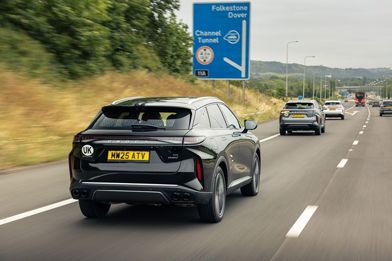What’s the best way to stick out from the pack in a sea of imitators in the burgeoning performance SUV segment? Design something that is about performance, but not an SUV.
Autocar UK has reported that an M3 Touring (station wagon) has been included in production plans for the new-gen 3 Series Touring range, which will start rolling down the production lines next year, following the recent unveiling of the latest 3 Series sedan.
This is interesting on two levels. First, would you believe it, but for some reason BMW has never had an M3 Touring before.
While arch rivals Mercedes-Benz and Audi have made masses of money from their AMG C 63 Estate and RS4 Avant wagons respectively over several generations, BMW has ignored the opportunity to add a bigger boot to the proven M3 formula. Even Volkswagen has had a go with the smaller but no less excellent Golf R Wagon.
The arrival of an M3 Touring would — on paper at least — represent a tasty development. Here in the Good Oil offices, we’ve always considered the wagon-y version of BMW’s 3 Series the unjustly overlooked sweet spot in the model line.
But could this be a sign t he market (especially where performance brands desperately wishing to excite their rabid audiences are concerned) is experiencing the first signs of SUV fatigue?
Before the rise and rise of the SUV, the station wagon was the XL-sized catch-all for practicality matched with a bit of zing. Aside from, perhaps, hot versions of Aussie Fords, it was the Germans who successfully mapped extra horses on to the station wagon blueprint.
The updated sedan version of the M3 (the only way one can currently buy the nameplate) will be shown off before the end of the year.
But expect some tempting Touring action to surface on the BMW stand at the Geneva motor show next March.
Mercury Coupe simply the coolest EV restomod made
The Mercury’s faded glory remains intact. Photo / Supplied
In the fast-evolving world of EV engineering, the idea of an old car sporting new tech no longer has the zany impact it might’ve had five years ago.
We’ve seen Volkswagen Kombis running electric motors, and similarly powered American fare make a smooth and silent appearance from enthusiasts as diverse as musician and vintage car buff, Neil Young, and New Zealand’s own Mercury Energy.
LA-based restomodder, Icon, might have nailed the concept though with its latest project, unveiled at the SEMA automotive trade show in Las Vegas.
Part of Icon’s Derelict series of one-off builds, this all-electric 1949 Mercury Coupe looks sensational. And it’s possibly down to the customiser’s admirable resistance to polishing every external panel to sparkle like the sun.
Aside from the high-tech electric powertrain under the substantial hood, as much external patina (read: corrosion) and internal character has been left in-situ as possible.
That’s not to say Icon didn’t pull the donor car apart with the precision of a surgical team: it did, but managed to keep as much of the Mercury’s faded glory intact as possible. The makeover included new rubber, extra sound-deadening material and insulation.
The upholstery is new, but colour-matched to give it a sun-faded look and Icon stuck with the original bulky bench seats.
Look closer at the dash and you’ll see retro-themed — but distinctly digital — switchgear, and the car has obviously been lowered (and features Brembo brakes). But for the most part, this is a ground-up restoration that looks like it has just been pulled out of the barn.
Lift the bonnet, and things do look decidedly different… though even the Tesla-sourced 85kWh battery system and twin electric motor set-up has been styled to represent a trad V8 block.
According to the build team, there’s power for a 200km/h top speed and the Mercury features not one, but two charge ports: a CHAdeMo 125-amp inlet has been cleverly hidden away behind the front number plate, while a Tesla supercharger port is nestled underneath the fuel filler flap.
Sorry Mercury Energy; your gleaming 57 Ford Fairlane Evie is great and all. But this Mercury is so much cooler.
Grand prix for Vietnam?
The Southeast Asian nation of Vietnam appears to have discovered a rich seam of motor mania in its makeup of late.
A few months back, the auto world was wowed by the arrival of two rear-wheel drive models from new Vietnamese manufacturer VinFast; a good-looking Pininfarina-penned SUV and sedan pairing (based on borrowed BMW architecture) that show plenty of promise.
The VinFast cause has also been helped along by an inexplicable but not insubstantial David Beckham endorsement.
Now, with Formula 1’s end-of-season gossip mill about who’s likely to be driving for whom next year, the background chat about likely newcomers to the race schedule has also heated up.
Should we perhaps be unsurprised, then, that Vietnam is on the list for new races commencing in 2020?
Given Vinfast’s 9-100 launch with real hardware backed by real players in the car industry, probably not.
It seems there are deep-pocketed players in the country who want their dose of motorsport drama. The annual race fees payable to Liberty Media for hosting a round of the F1 championship are reportedly about US$20m.
It appears that a street race in Hanoi, the capital, is the favoured bid. It’ll be added to petitions to the FIA and F1 owner, Liberty Media, from Miami and the Netherlands for 2020 race calendar appearances.
Though Miami would represent a glitzy but familiar take on an F1 race (think Monaco, but with less hills and more US Airforce fly-pasts) a street race through the colourful and chaotic streets of Hanoi sounds compelling.
We’ll be curious, though, as to how this city of a million scooters will cope with the disruption.




